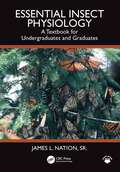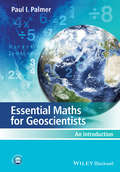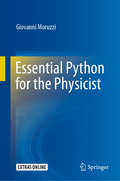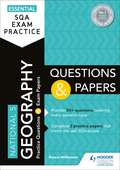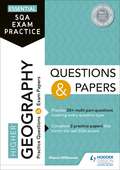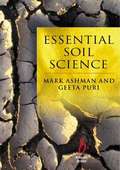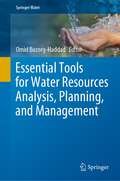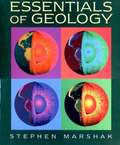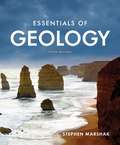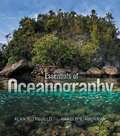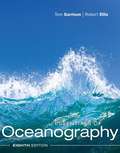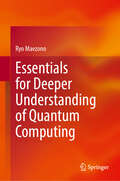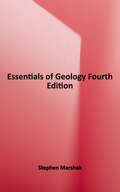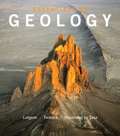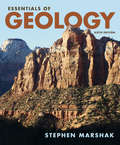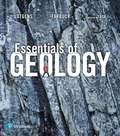- Table View
- List View
Essential Insect Physiology: A Textbook for Undergraduates and Graduates
by James L. Nation, Sr.This textbook is the first to teach insect physiology and biology specifically to students who lack a strong background in biochemistry and molecular biology. Avoiding taxonomic language and supported with high‑quality figures, chapter summaries, end‑of‑chapter review questions, and a suite of PowerPoint slides for use in teaching, it describes the fundamental processes. These include molting and metamorphosis, digestion of food, nerve and muscle function, flight, biological rhythms, circulation and breathing, immunity, how climate and climate change have, and are, affecting insects, and the use of new manipulation of the genome in insect biology and control.Introducing the topic with the story of insect development in Chapter 1, this text makes insect physiology and biology genuinely interesting to students, right through to the final chapter, which discusses studies in editing the insect genome.
Essential Invitation To Oceanography
by Paul PinetIntended for the more concise course, Essential Invitation to Oceanography provides a thorough introduction to oceanographic concepts while omitting advanced topics that some courses do not require. Written for the non-science student, this text lets readers explore how the oceans work while explaining their relevance within the four major divisions of ocean science--geology, chemistry, physics, and biology. A student-friendly writing style and rich pedagogy help students fully understand and retain the important concepts at hand, and feature boxes throughout engage them with the fascinating discoveries in oceanography.
Essential Maths for Geoscientists
by Paul I. PalmerMaths for Geoscientists is an accessible, student-friendly introduction to the essential mathematics required by those students taking degree courses within the Geosciences. Clearly structured throughout, this book carefully guides the student step by step through the mathematics they will encounter and will provide numerous applied examples throughout to enhance students understanding and to place each technique into context.Opening with a chapter explaining the need for studying mathematics within geosciences the book then moves on to cover algebra, equations, solutions, logarithms and exponentials, statistics and probability, trigonometry, vectors and calculus. The final chapter helps to bring it all together and provides the students with sample projects to test their knowledge. Worked applied examples are included in each chapter along with applied problem questions which are a mix of straightforward maths questions, word questions (developing maths to words), and more involved questions that involve the manipulation and interpretation of real and synthetic data.
Essential Muir (Revised): A Selection of John Muir’s Best (and Worst) Writings
by John MuirEssayist. Preservationist. Mountain man. Inventor. John Muir may be California’s best-known icon. A literary naturalist and founder of the Sierra Club and Yosemite National Park, Muir left his legacy on the landscape and on paper. But the celebrity of John Muir does not tell the whole story. In Essential Muir, for the first time, Muir's selected writings include those that show his ecological vision without ignoring his racism, providing a more complete portrait of the man. Taking the best of John Muir’s writings on nature and placing them alongside his musings on religion, society, and his fellow humans, Essential Muir asks the reader to consider how these connect, and what that means for Muir’s legacy in environmentalism today. Fred D. White’s selections from Muir’s writings, and his illuminating commentary in his revised introduction, reveal the complex man and writer behind the iconic name. In the new foreword, Jolie Varela (Tule River Yokut and Paiute) of Indigenous Women Hike speaks back to Muir, addressing the impact of his words and actions on California Indians. This collection, which highlights John Muir’s charms and confronts his flaws, is vital for understanding the history of environmental thought.
Essential Oceanography
by Harold V. Thurman Allen P. TrujilloThe book's content was carefully developed to provide a foundation in science by examining the vast body of oceanic knowledge. This knowledge includes information from a variety of scientific disciplines -- geology, chemistry, physics, and biology -- as they relate to the oceans. However, no formal background in any of these disciplines is required to successfully master the subject matter contained within this book. Our desire is to have you take away from your oceanography course much more than just a collection of facts. Instead, we want you to develop a fundamental understanding of how the oceans work (why the oceans behave the way that they do).
Essential Python for the Physicist
by Giovanni MoruzziThis book introduces the reader with little or no previous computer-programming experience to the Python programming language of interest for a physicist or a natural-sciences student. The book starts with basic interactive Python in order to acquire an introductory familiarity with the language, than tackle Python scripts (programs) of increasing complexity, that the reader is invited to run on her/his computer. All program listings are discussed in detail, and the reader is invited to experiment on what happens if some code lines are modified. The reader is introduced to Matplotlib graphics for the generation of figures representing data and function plots and, for instance, field lines. Animated function plots are also considered. A chapter is dedicated to the numerical solution of algebraic and transcendental equations, the basic mathematical principles are discussed and the available Python tools for the solution are presented. A further chapter is dedicated to the numerical solution of ordinary differential equations. This is of vital importance for the physicist, since differential equations are at the base of both classical physics (Newton’s equations) and quantum mechanics (Schroedinger’s equation). The shooting method for the numerical solution of ordinary differential equations with boundary conditions at two boundaries is also presented. Python programs for the solution of two quantum-mechanics problems are discussed as examples. Two chapters are dedicated to Tkinter graphics, which gives the user more freedom than Matplotlib, and to Tkinter animation. Programs displaying the animation of physical problems involving the solution of ordinary differential equations (for which in most cases there is no algebraic solution) in real time are presented and discussed. Finally, 3D animation is presented with Vpython.
Essential Rammed Earth Construction: The Complete Step-by-Step Guide (Sustainable Building Essentials)
by Tim Krahn&“All of the essential knowledge for completing a successful rammed earth project. Written by a geo-technical engineer with experience ramming earth.&” —Kelly Hart, author, Essential Earthbag Construction Everything you need to know to build with rammed earth in warm and cold climates. Rammed earth—sand, gravel, and clay or lime/cement binder packed into forms—is a low-energy, high-performance building method, yielding beautiful, sustainable results. It&’s thermally stable and can be insulated, can actively modulate humidity, provides a healthy indoor environment, and allows site materials to be used for major structural and building envelope elements.Essential Rammed Earth Construction covers design, building science, tools, and step-by-step building methods for any climate, with a special emphasis on building in cold climates of the northern US, Canada, and northern Europe. Coverage includes: Overview of earthen building Appropriate use of rammed earth walls Stabilized versus raw rammed earth Design considerations, including structural, insulation, and building envelope details Special considerations for cold and freeze-thaw climates Construction drawings, with step-by-step building instructions Tools and labor covering industrial methods, low-tech techniques, formwork options, mix design, budgets, and schedules Codes, inspections, and permits. This guide is an essential resource for experienced builders, DIY home owners, designers, engineers, and architects. &“A much-needed and science-based update to a North American audience of designers, engineers and builders.&” —Bruce King. P.E., author, The New Carbon Architecture &“ A great book for anyone who wants to deepen their technical knowledge of rammed earth walls systems. It&’s very helpful to have a book on rammed earth that is more focused on engineered rammed earth walls for cold climates.&” —Clifton Schooley, Clifton Schooley & Associates, Rammed Earth Designers and Builders
Essential SQA Exam Practice: From the publisher of How to Pass
by Sheena WilliamsonExam board: SQALevel: National 5Subject: GeographyFirst teaching: September 2017First exam: Summer 2018Practice makes permanent. Feel confident and prepared for the SQA National 5 Geography exam with this two-in-one book, containing practice questions for every question type and the most popular topics, plus two full practice papers.- Choose to revise by question type or topic: A simple grid enables you to pick particular question styles or course areas that you want to focus on, with answers provided at the back of the book- Understand what the examiner is looking for: Clear guidance on how to answer each question type is followed by plenty of questions so you can put the advice into practice, building essential exam skills- Remember more in your exam: Repeated and extended practice will give you a secure knowledge of the key areas of the course (physical environments; human environments; global issues)- Familiarise yourself with the exam paper: Both practice papers mirror the language and layout of the real SQA papers; complete them in timed, exam-style conditions to increase your confidence before the exams- Find out how to achieve a better grade: Answers to the practice papers have commentaries for each question, with tips on writing successful answers and avoiding common mistakesFully up to date with SQA's requirementsThe questions, mark schemes and guidance in this practice book match the requirements of the revised SQA National 5 Geography specification for examination from 2018 onwards.This book covers the following topics:Section 1: Physical Environments:- Landscape Types- WeatherSection 2: Human Environments:- World Population Distribution and Change- Issues in Changing Urban and Rural LandscapesSection 3: Global Issues:- Climate Change- Natural Regions- Environmental Hazards- Trade and Globalisation- Tourism- Health
Essential SQA Exam Practice: From the publisher of How to Pass
by Sheena WilliamsonExam board: SQALevel: HigherSubject: GeographyFirst teaching: September 2018First exam: Summer 2019Practice makes permanent. Feel confident and prepared for the SQA Higher Geography exam with this two-in-one book, containing practice questions for every question type and the most popular topics, plus two practice papers.- Choose to revise by question type or topic: A simple grid enables you to pick particular question styles or course areas that you want to focus on, with answers provided at the back of the book- Understand what the examiner is looking for: Clear guidance on how to answer each question type is followed by plenty of questions so you can put the advice into practice, building essential exam skills- Remember more in your exam: Repeated and extended practice will give you a secure knowledge of the key areas of the course (physical environments; human environments; global issues)- Familiarise yourself with the exam papers: Both practice papers mirror the language and layout of the real SQA papers; complete them in timed, exam-style conditions to increase your confidence before the exams- Find out how to achieve a better grade: Answers to the practice papers have commentaries for each question, with tips on writing successful answers and avoiding common mistakesFully up to date with SQA's requirementsThe questions, mark schemes and guidance in this practice book match the requirements of the revised SQA Higher Geography specification for examination from 2019 onwards.This book covers the following topics:Physical environments:- Atmosphere- Hydrosphere- Lithosphere- BiosphereHuman environments:- Population- Urban- RuralGlobal issues:- River basin management- Development and health- Climate change- Energy
Essential SQA Exam Practice: Higher Geography Questions and Papers
by Sheena WilliamsonExam board: SQALevel: HigherSubject: GeographyFirst teaching: September 2018First exam: Summer 2019Practice makes permanent. Feel confident and prepared for the SQA Higher Geography exam with this two-in-one book, containing practice questions for every question type and the most popular topics, plus two practice papers.- Choose to revise by question type or topic: A simple grid enables you to pick particular question styles or course areas that you want to focus on, with answers provided at the back of the book- Understand what the examiner is looking for: Clear guidance on how to answer each question type is followed by plenty of questions so you can put the advice into practice, building essential exam skills- Remember more in your exam: Repeated and extended practice will give you a secure knowledge of the key areas of the course (physical environments; human environments; global issues)- Familiarise yourself with the exam papers: Both practice papers mirror the language and layout of the real SQA papers; complete them in timed, exam-style conditions to increase your confidence before the exams- Find out how to achieve a better grade: Answers to the practice papers have commentaries for each question, with tips on writing successful answers and avoiding common mistakesFully up to date with SQA's requirementsThe questions, mark schemes and guidance in this practice book match the requirements of the revised SQA Higher Geography specification for examination from 2019 onwards.This book covers the following topics:Physical environments:- Atmosphere- Hydrosphere- Lithosphere- BiosphereHuman environments:- Population- Urban- RuralGlobal issues:- River basin management- Development and health- Climate change- Energy
Essential SQA Exam Practice: National 5 Geography Questions and Papers
by Sheena WilliamsonExam board: SQALevel: National 5Subject: GeographyFirst teaching: September 2017First exam: Summer 2018Practice makes permanent. Feel confident and prepared for the SQA National 5 Geography exam with this two-in-one book, containing practice questions for every question type and the most popular topics, plus two full practice papers.- Choose to revise by question type or topic: A simple grid enables you to pick particular question styles or course areas that you want to focus on, with answers provided at the back of the book- Understand what the examiner is looking for: Clear guidance on how to answer each question type is followed by plenty of questions so you can put the advice into practice, building essential exam skills- Remember more in your exam: Repeated and extended practice will give you a secure knowledge of the key areas of the course (physical environments; human environments; global issues)- Familiarise yourself with the exam paper: Both practice papers mirror the language and layout of the real SQA papers; complete them in timed, exam-style conditions to increase your confidence before the exams- Find out how to achieve a better grade: Answers to the practice papers have commentaries for each question, with tips on writing successful answers and avoiding common mistakesFully up to date with SQA's requirementsThe questions, mark schemes and guidance in this practice book match the requirements of the revised SQA National 5 Geography specification for examination from 2018 onwards.This book covers the following topics:Section 1: Physical Environments:- Landscape Types- WeatherSection 2: Human Environments:- World Population Distribution and Change- Issues in Changing Urban and Rural LandscapesSection 3: Global Issues:- Climate Change- Natural Regions- Environmental Hazards- Trade and Globalisation- Tourism- Health
Essential Soil Science: A Clear and Concise Introduction to Soil Science
by Mark Ashman Geeta PuriThis textbook is aimed at the majority of students, who need to quickly acquire a concise overview of soil science. Many current soil science textbooks still cater for a traditional student market where students embark on three years study in a narrow discipline. The growth in modular degree schemes has meant that soil science is now often taught as self-standing unit as part of broad based degree program. Students pursuing this type of course are increasingly reluctant to purchase expensive textbooks that are too detailed and often assume a scientific background. For those opting to specialise in soil science there are a variety of good textbooks to choose from. This short informative guide, will be particularly useful for students who do not possess a traditional scientific background, such as those studying geography, environment science, ecology and agriculture. Only textbook to cater for introductory courses in soil science. Provides an affordable concise overview of soil science. Learning exercises and chapter summaries enhance usability. Annotated suggestions for further reading. Based on proven and successful modular course structure. Emphasis on readability and interactive learning. No scientific background assumed.
Essential Statistical Physics
by Malcolm P. KennettThis clear and pedagogical text delivers a concise overview of classical and quantum statistical physics. Essential Statistical Physics shows students how to relate the macroscopic properties of physical systems to their microscopic degrees of freedom, preparing them for graduate courses in areas such as biophysics, condensed matter physics, atomic physics and statistical mechanics. Topics covered include the microcanonical, canonical, and grand canonical ensembles, Liouville's Theorem, Kinetic Theory, non-interacting Fermi and Bose systems and phase transitions, and the Ising model. Detailed steps are given in mathematical derivations, allowing students to quickly develop a deep understanding of statistical techniques. End-of-chapter problems reinforce key concepts and introduce more advanced applications, and appendices provide a detailed review of thermodynamics and related mathematical results. This succinct book offers a fresh and intuitive approach to one of the most challenging topics in the core physics curriculum and provides students with a solid foundation for tackling advanced topics in statistical mechanics.
Essential Sustainable Home Design: A Complete Guide to Goals, Options, and the Planning Process (Sustainable Building Essentials)
by Chris MagwoodDesign your own sustainable home Many people dream of building a beautiful, environmentally friendly home. But until now there has been no systematic guide to help potential builders work through the complete process of imagining, planning, designing, and building their ideal, sustainable home. Essential Sustainable Home Design walks potential homebuilders through the process starting with key concepts, principles, and a project vision that will guide the house to completion.Coverage includes:How to clarify your ideas and create a practical pathway to achieving your dreamA criteria matrix to guide design, material, and systems decisionsCreating a strong, integrated design team and working with professionals and code officials to keep the project on track from start to finish.Key building science concepts that make for a high-performance, durable buildingPrimer on building logistics, material sourcing, and protocols to ensure that the initial vision for the project comes to fruition.One-page summaries and ratings of popular sustainable building materials and system options.Ideal for owner-builders and sustainable building contractors working with clients aiming to design and build a sustainable home. Chris Magwood has designed and built some of the most innovative, sustainable buildings in North America, including the first off-grid, straw bale home in Ontario. He is co-founder and director the Endeavour Centre for Innovative Building and Living and co-editor of the Sustainable Building Essentials series. Chris is the author of Essential Prefab Straw Bale Construction, Essential Hempcrete Construction, Straw Bale Details, More Straw Bale Building , and Making Better Buildings .
Essential Tools for Water Resources Analysis, Planning, and Management (Springer Water)
by Omid Bozorg-HaddadThis book describes concepts and tools needed for water resources management, including methods for modeling, simulation, optimization, big data analysis, data mining, remote sensing, geographical information system, game theory, conflict resolution, System dynamics, agent-based models, multiobjective, multicriteria, and multiattribute decision making and risk and uncertainty analysis, for better and sustainable management of water resources and consumption, thus mitigating the present and future global water shortage crisis. It presents the applications of these tools through case studies which demonstrate its benefits of proper management of water resources systems. This book acts as a reference for students, professors, industrial practitioners, and stakeholders in the field of water resources and hydrology.
Essentials Of Geology
by Stephen MarshakIn this introductory textbook, Marshak (University of Illinois) incorporates the theory of plate tectonics and the concept of Earth science systems into discussions of rock types, volcanoes and earthquakes, crustal deformation and mountains, energy and mineral resources, water, ice, global change and other standard topics. Color photographs and diagrams illustrate the major ideas of the book, and a companion CD-ROM contains animated clips representing the processes described in the text.
Essentials Of Geology (Fifth Edition)
by Stephen MarshakWhy do earthquakes, volcanoes, floods, and landslides happen? What causes mountains to rise? How do beautiful landscapes develop? Do climate and life change through time? When did the Earth form, and by what process? Where do we dig to find valuable metals, and where do we drill to find oil? Does sea level change? Can continents move? <P><P>The study of geology addresses these important questions and many more. But from the birth of the discipline in the late-18th century until the mid-20th century, geologists considered each question largely in isolation, without pondering its relation to the others. <P><P>This approach changed, beginning in the 1960s, in response to the formulation of two "paradigm-shifting" ideas that have unified thinking about the Earth and its features. The first idea, called the theory of plate tectonics, states that the Earth's outer shell consists of discrete plates that slowly move relative to each other so that the map of our planet continuously changes. <P><P>Plate interactions cause earthquakes and volcanoes, build mountains, provide gases that make up the atmosphere, and affect the distribution of life on Earth. The second idea, called the Earth System concept, emphasizes that our planet's water, land, atmosphere, and living inhabitants are dynamically interconnected. In the Earth System, materials constantly cycle among various living and nonliving reservoirs on, above, and within the planet. We have come to realize that the history of life is intimately linked to the history of the physical Earth.
Essentials Of Oceanography
by Harold V. Thurman Alan P. TrujilloEssentials of Oceanography guides readers through the complexities of what lies beneath the ocean. With an interdisciplinary approach and accessible writing style, the text is engaging for all readers. The 12th Edition discusses the ocean’s biological, chemical, geological, and physical components for an in-depth understanding of this vast and elaborate topic. Complex concepts are made engaging with extensively revised art and interactive study aids that keep readers interested and excited about the material.
Essentials Of Oceanography (Eighth Edition)
by Robert Ellis Tom GarrisonESSENTIALS OF OCEANOGRAPHY provides a basic understanding of the complexities and uncertainties involved in ocean use and the importance of oceans in nurturing and sustaining life. Streamlined to remove nonessential technical details so students can focus on the content without interruptions to the narrative, the 8th Edition's slimmer table of contents allows instructors to cover one chapter a week -- while leaving some extra time in the semester. Using exclusive content from the National Geographic Society, ESSENTIALS OF OCEANOGRAPHY, 8th Edition, illustrates the complexity and beauty of the ocean while making it more accessible to a wider range of students. With this book, bestselling authors Tom Garrison and Robert Ellis illustrate the interdisciplinary nature of marine science and give students the most dynamic and current introduction to oceanography available today.
Essentials for Deeper Understanding of Quantum Computing
by Ryo MaezonoThis textbook provides a self-contained basic tutorial to help readers confidently understand and comprehend the fundamental element of quantum computing, that is, the "quantum state (spin) represented by the Bloch sphere." The primary target audience includes readers from information technology or business fields who are entering the quantum computing domain without prior experience in physics courses. Additionally, the content is designed to be a valuable refresher for those already familiar with physics or those teaching quantum physics. This volume overcomes the difficulties of existing quantum computing tutorials by providing a solution that demonstrates how, given a semester's worth of time, readers with a high school level of mathematics can be introduced to the concept of spinors without any top-down explanations. Avoiding top-down explanations entirely, the book explains the necessary minimum mathematics and physics in a logically natural progression to help readers understand why we think in such ways. The focus is on understanding the interrelationships between theories—what knowledge is needed to understand what concepts. Everything extraneous to understanding the logical flow has been meticulously removed. The goal is to efficiently bring readers to a level where they can approach quantum computing without any background knowledge anxieties.
Essentials of Geology
by Stephen MarshakSuperior visuals and up-to-date research help students see the world like a geologist. The Fourth Edition offers a streamlined, engaging approach to geologic processes, presented through visuals, photographs, and text, as well as discussions of modern science phenomena.
Essentials of Geology (12th Edition)
by Edward J. Tarbuck Frederick K. Lutgens Dennis G. TasaFrom the renowned Lutgens/Tarbuck/Tasa team, the Twelfth Edition of Essentials of Geology continues to elevate its readability, art program, focus on basic principles and instructor flexibility. This revision incorporates what has historically made the text a best seller with a new active learning approach throughout each chapter, which offers students a structured learning path and provides a reliable, consistent framework for mastering the chapter concepts. It also includes new additions to its learning path, mobile field trips, and visual program. This edition is supported by MasteringGeology(tm)-used by over 1. 5 million science students, the Mastering platform is the most effective and widely used online tutorial, homework, and assessment system for the sciences. This program will provide an interactive and engaging learning experience for your students. Here's how: Personalize learning with MasteringGeology: MasteringGeology provides students with engaging and interactive experiences that coach them through introductory physical geography with specific wrong-answer feedback, hints, and a wide variety of educationally effective content. Teach with an active learning path that emphasizes learning objectives, tie questions back to objectives, ask students to analyze, synthesize, and critically think about core concepts, and break down chapter content. Engage students with an art program that supports a structured learning path with its bold-magazine like design Note: You are purchasing a standalone product; My_Lab/Mastering does not come packaged with this content. If you would like to purchase both the physical text and My_Lab/Mastering search for ISBN-10: 0321949803/ISBN-13: 9780321949806. That package includes ISBN-10: 0321947738/ISBN-13: 9780321947734 and ISBN-10: 0321966864/ISBN-13: 9780321966865. My_Lab/Mastering is not a self-paced technology and should only be purchased when required by an instructor.
Essentials of Geology (Seventh Edition)
by Stephen MarshakMarshak geology meets active, virtual learning. The gold standard text for helping students visualize and understand geologic processes makes hands-on and real-world exploration easier and more impactful than ever, in any course setting. New 3D specimen and digital elevation models, with corresponding Smartwork exercises, allow students to examine specimens and sites as if they were in the field or lab. And new highly visual “Practice What You Know” and “What Can You See?” activities at the end of each chapter and in Smartwork help students synthesize and apply important concepts like a geologist. Thoroughly updated with current events and essential data, the Seventh Edition also reveals the dynamism of geology and how it impacts our lives This purchase offers access to the digital ebook only.
Essentials of Geology (Sixth Edition)
by Stephen MarshakA hands-on, visual learning experience for physical geology This purchase offers access to the digital ebook only.
Essentials of Geology (Thirteenth Edition)
by Frederick K. Lutgens Dennis Tasa Edward TarbuckUsing dynamic media to bring geology to life From the renowned Lutgens/Tarbuck/Tasa team, the 13th Edition of Essentials of Geology continues to elevate the text's readability, illustrations, and focus on basic principles. This revision incorporates a structured learning path and reliable, consistent framework for mastering the chapter concepts. With a fully integrated mobile media program that includes new Mobile Field Trip and Project Condor quadcopter videos as well as new animations and videos, this edition provides a unique, interactive, and engaging learning experience for readers.
